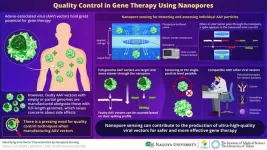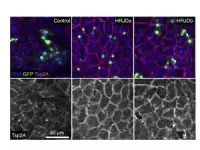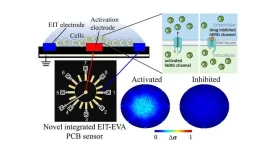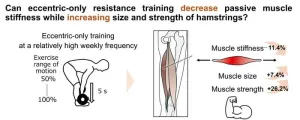Novel nanosensing technique for quality control of viral vectors in gene therapy
2024-08-01
(Press-News.org)
Over the past few decades, there has been remarkable progress in genetic manipulation technologies, bringing us closer to the point where genes can be modified in vivo. Such tools would open up the way to gene therapy, ushering in a new era in medicine. Thus far, the most promising strategies for gene therapy involve leveraging the existing molecular machinery found in viruses.
In particular, adeno-associated virus (AAV) vectors have recently garnered significant attention from the scientific community, given their potential to serve as nucleic acid vaccines for diseases like COVID-19. However, during AAV vector manufacturing, some particles may carry only a partial copy of the intended genome, while others may be empty. These defective vectors can lead to unexpected side effects, underscoring the urgent need for robust quality control methods in their production.
Addressing this challenge, a team of researchers from Japan recently reported a novel nanosensing technique to measure viral vector characteristics. Their findings were presented in their latest paper, published online on 5 June, 2024 in ACS Nano. The team includes Associate Professor Makusu Tsutsui from the Institute of Scientific and Industrial Research at Osaka University; Professor Tomoji Kawai, also from the same institute; Lecturer Akihide Arima from the Institute of Nano-Life-Systems at Nagoya University; Specially Appointed Professor Yoshinobu Baba from the Institute of Nano-Life-Systems Institutes of Innovation for Future Society, Nagoya University; Project Researcher Mikako Wada and Assistant Professor Yuji Tsunekawa, both from the Institute of Medical Science at The University of Tokyo; and Professor Takashi Okada, also from the Institute of Medical Science at The University of Tokyo.
The proposed approach involves measuring the ionic current that flows through a nanopore opening when a voltage differential is applied to a solution containing AAVs. When the nanopore is unobstructed, the measured ionic current is relatively constant. But when a viral particle passes through the nanopore, the flow of ions is partially blocked for a brief moment, producing a spike or pulse in the ionic current readout.
Interestingly, because AAV vectors with full genomes are heavier and slightly bulkier than empty or partially filled vectors, it’s possible to discriminate between them as they pass through the nanopore—faulty vectors produce a ‘signature’ in the measured ionic current that is noticeably different from that of full-genome vectors. The team verified this through experiments, finite-element simulations, and theoretical analyses. “By designing a sensor with an optimal structure, we identified for the first time the gene-derived sub-nanometer-scale differences in the size of the viral vectors,” explains Tsutsui.
This technique allows for the convenient and inexpensive quality control of AAV vectors, which thus far has relied on complex methods such as mass photometry, transmission electron microscopy, and analytical ultracentrifugation. “The present work may revolutionize medicine by providing a tool for preparing AAV vectors with ultra-high quality for safe and effective gene therapy,” highlights Tsunekawa. “It may be key in the development of production and purification systems for AAV vectors,” he further adds.
Moreover, beyond AAV vectors, this approach holds promise for studying other types of viral vectors, potentially opening new avenues for effective gene therapies and advancing our understanding of viral biology. Moreover, ensuring the high quality of clinically used AAV vectors could allow for lower patient doses, thereby minimizing side effects.
Let us hope these efforts serve as a stepping stone towards effective treatments for hereditary disorders, as well as challenging diseases like cancer.
END
ELSE PRESS RELEASES FROM THIS DATE:
2024-08-01
When developing new drugs, understanding their effects on ion channels in the body, such as the human ether-a-go-go-related gene (hERG) ion channel found in neurons and heart muscle cells, is critical. Blocking hERG channels can disrupt normal heart rhythm, potentially leading to a fatal condition known as torsade de pointes. Current methods for assessing these effects typically involve invasive procedures like patch-clamp techniques or fluorescence microscopy. These methods alter cell properties and may affect measurement accuracy, requiring specialized equipment ...
2024-08-01
Much of the water in the West is transported across vast geographical areas by large infrastructure projects known as interbasin water transfers. Two of these projects in particular make up 85% of all energy-related greenhouse gas emissions associated with U.S. interbasin transfers — one in Arizona and the other in California — according to the new research published this week in the journal Nature Water.
The project in Arizona is known as the Central Arizona Project and in California it’s the State Water Project.
“You hear a lot about these big projects and how much energy they use,” said Avery Driscoll, a doctoral student in ...
2024-08-01
Higher levels of urinary metals such as cadmium, tungsten, uranium, cobalt, copper and zinc are linked to increased cardiovascular disease and mortality in a racially and ethnically diverse U.S. population, according to a new study at Columbia University Mailman School of Public Health. While it is well documented that exposure to certain metals has been associated with cardiovascular disease (CVD) and mortality, until now the evidence was limited beyond arsenic, cadmium, and lead and for a racially diverse population. The findings are published in the journal Circulation.
When analyzed together, ...
2024-08-01
Human-made climate change can lead to a destabilisation of large-scale components of the Earth system such as ice sheets or ocean circulation patterns, the so-called tipping elements. While these components will not tip over night, fundamental processes are put into motion unfolding over tens, hundreds or thousands of years. These changes are of such a serious nature that they should be avoided at all costs, the researchers argue. In their new study, they assessed the risks of destabilisation of at least one ...
2024-08-01
For some forms of tuberculosis, the chances that an exposed person will get infected depend on whether the individual and the bacteria share a hometown, according to a new study comparing how different strains move through mixed populations in cosmopolitan cities.
Results of the research, led by Harvard Medical School scientists and published Aug. 1 in Nature Microbiology, provide the first hard evidence of long-standing observations that have led scientists to suspect that pathogen, place, and human host ...
2024-08-01
LA JOLLA, CA—To diagnose heart conditions including heart attacks and heart rhythm disturbances, clinicians typically rely on 12-lead electrocardiograms (ECGs)—complex arrangements of electrodes and wires placed around the chest and limbs to detect the heart’s electrical activity. But these ECGs require specialized equipment and expertise, and not all clinics have the capability to perform them.
Now, a team of scientists and clinicians from Scripps Research has shown that heart conditions can be diagnosed roughly as accurately using just three electrodes and an artificial intelligence (AI) tool. In a ...
2024-08-01
Current climate policies imply a high risk for tipping of critical Earth system elements, even if temperatures return to below 1.5°C of global warming after a period of overshoot. A new study indicates that these risks can be minimized if warming is swiftly reversed.
Human-made climate change can lead to a destabilization of large-scale components of the Earth system such as ice sheets, ocean circulation patterns, or global biosphere components, the so-called tipping elements. In their new study published in Nature Communications, researchers from IIASA and the Potsdam Institute for Climate Impact Research (PIK) analyzed the risks for four interconnected core climate tipping elements ...
2024-08-01
Vaccines are safe and effective, and help reduce death and illness. But global vaccination rates are suboptimal and have trended downward, leaving humanity more vulnerable to vaccine-preventable diseases such as COVID-19, influenza, measles, polio, and HPV.
Identifying interventions that could increase vaccine coverage could help save lives. A new paper from a team led by researchers at the University of Pennsylvania offers the first comprehensive meta-analysis examining what types of vaccine intervention strategies have the ...
2024-08-01
Osaka, Japan — An aging society has posed a new global problem, the risk of falling. It is estimated that 1 in 3 adults over the age of 65 falls each year and the resulting injuries are becoming more prevalent.
To tackle this growing issue, Associate Professor Hiromitsu Toyoda and Specially Appointed Professor Tadashi Okano from Osaka Metropolitan University’s Graduate School of Medicine, together with Professor Chisato Hayashi from the University of Hyogo, have developed a formula and assessment tool for estimating fall risks that is simple for older adults to use. The tool was developed using data collected from older adults over a ten-year period from April 2010 to December ...
2024-08-01
Resistance, or weight training, is widely recommended in sports and rehabilitation as an effective exercise to increase muscular strength and size. This form of exercise involves applying resistance to muscle contraction to build strength. However, some practitioners believe resistance training can increase passive muscle stiffness over time. Passive muscle stiffness is a key indicator of how muscles behave mechanically when they are stretched without active contraction. Specifically, it refers to the amount of force required to change the muscle length by a given amount during passive stretching. Studies ...
LAST 30 PRESS RELEASES:
[Press-News.org] Novel nanosensing technique for quality control of viral vectors in gene therapy






